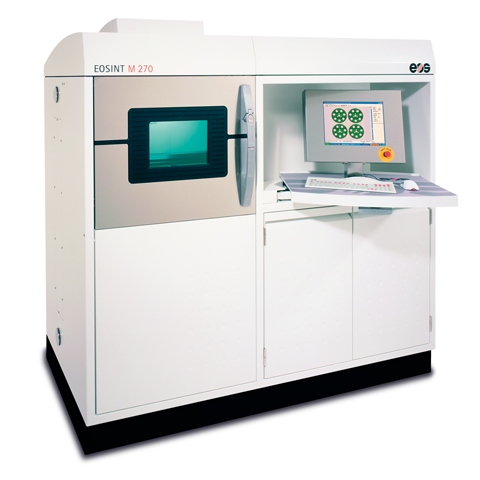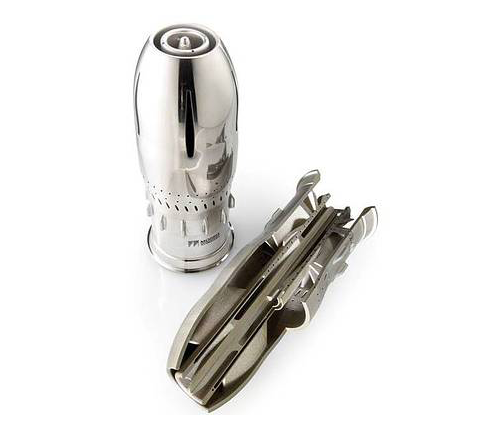
EOS’ M 270 Machine – gives you build capabilities for metals of an increasingly wide range of metal types in a 250 mm x 250 mm x 215 mm envelope
German rapid manufacturing vendor, EOS (Electro-Optical Systems) has just launched two new powdered metals for the rapid manufacture of nickel alloy and aluminium alloy components in its EOSINT M 270 laser-sintering systems (spec sheet is here – PDF). If you’ve not come across EOS before, they provide a range of processes, all based on laser optics systems building a variety of powders. The P series machines produce plastic derivative parts (although some of the most popular materials are aluminium and carbon-based powders), the S-series machines build using sand (for casting patterns and cores), while the M-series machines build using metals. The generic term for EOS’ metals process is DMLS, direct metal laser sintering. Don’t call it SLS – that’s a 3D Systems trademark term.
EOS NickelAlloy IN718
EOS NickelAlloy IN718 is a nickel-based, heat resistant superalloy which corresponds to Inconel 718. It is a precipitation hardening, nickel chromium alloy characterized by good tensile, fatigue, creep and rupture strengths at temperatures up to 700°C. It shows outstanding corrosion resistance, is ideal for many high temperature applications, and possesses excellent cryogenic properties.
The material will be of particular interest to the aerospace industry due to its demanding requirements. EOS has already carried out extensive tests in collaboration with several pilot customers. It has developed process parameters that enable good part building and ensure that the relevant industrial standards for this material type can be reliably fulfilled. These include, for example, heat treatment in accordance with AMS 5662 and AMS 5664 standards as well as tensile and stress rupture properties at elevated temperature (650°C).

Fuel Injection–Swirlers (actually built in EOS’ CobaltChrome MP1 material) courtesy of Morris Technologies
Greg Morris, President of pilot user Morris Technologies Inc in the US said: “We have been supplying parts in EOS CobaltChrome MP1 as a preferred material for high stress / high temperature environments since 2005. Since working with EOS NickelAlloy IN718, this has become our front-line material of choice for many applications in aerospace and other demanding applications. The material allows us to produce parts that will see some of the most demanding environments including high temperatures, high stress loads and extended fatigue situations. Not only has the sintered nickel alloy performed well in such tests and environments, but Morris Technologies’ material characterization efforts have also demonstrated that it performs to ASTM standards“.
Ian Halliday, CEO of pilot user 3T RPD in Newbury, UK, added: “EOS NickelAlloy IN718 has helped to open up new application areas for us. We are working with some of our customers to qualify this material for future series production of aerospace components. Tests have shown that the mechanical properties of parts built from the material exceed what our customers are used to from cast parts. They also report that the components are easier to machine than conventional Inconel 718.”
EOS Aluminium AlSi10Mg
The second material is EOS Aluminium AlSi10Mg powder, a typical casting alloy and the first aluminium-based powder to be qualified for EOSINT M 270 systems and opens up new application areas due to its light weight and thermal conductivity. Thorough process development and testing were performed as preparation for the launch. Cast parts in conventional AlSi10Mg are typically subjected to T6 heat treatment including solution annealing and quenching followed by age hardening at elevated temperatures.
Few thoughts
What I found interesting is a quote from the VP of M (Meaning Metals) Technology at EOS, Mike Shellabear claims that “Due to the rapid melting and resolidification caused by exposure to the lasers, the sintered parts match or even exceed conventional heat-treated parts in the as-built condition. So even more time and cost can be saved in the process chain.” This is something that’s been talked about with regards to metals for some time. Traditionally vendors have been aiming to develop processes which allow the user to replicate traditional production intent materials processed using traditional means (such as casting, machining, heat treatment etc) using direct manufacturing technology. While this is obviously still an end goal, it’s clear that the more advanced vendors are finding that the combination of materials and processes is creating a new set of materials with new capabilities. When combined with the freedom from many of the geometric limitations associated (but certainly not all by any means) with traditional production methods, this is truly exciting times.






